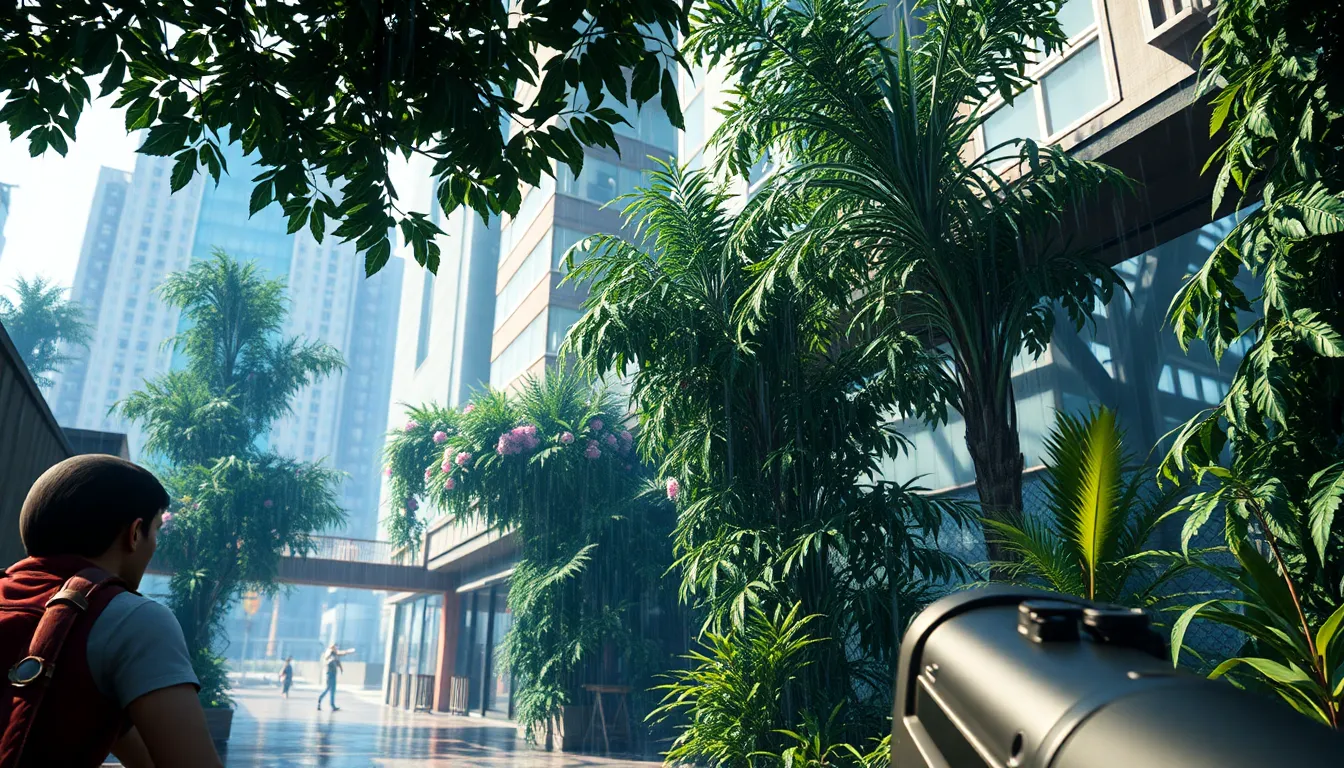Table of Contents
ToggleFirst-person shooter (FPS) games have taken the gaming world by storm, captivating millions with their adrenaline-pumping action and immersive experiences. As technology advances, the development of these games has become a fascinating blend of art and science, requiring a deep understanding of game mechanics, graphics, and player engagement.
Developers face unique challenges when creating FPS titles, from designing realistic environments to implementing responsive controls. With the rise of competitive gaming and eSports, the demand for innovative and high-quality FPS games continues to grow. This article dives into the key aspects of FPS development, exploring the techniques and tools that bring these thrilling virtual worlds to life.
Overview of FPS Development
FPS development involves intricate processes that combine technology, creativity, and player engagement. Game mechanics define core gameplay elements such as movement, shooting, and objectives. Developers focus on creating intuitive and responsive controls to enhance player experiences.
Graphics engine selection plays a significant role in FPS titles. Popular engines like Unreal Engine and Unity provide tools for realistic rendering and physics simulations. These engines enable developers to create visually stunning environments that immerse players.
Level design significantly influences gameplay flow. Effective level design includes strategic placement of cover, enemies, and objectives. Developers employ techniques like playtesting to refine levels and ensure they meet player expectations.
Artificial intelligence (AI) systems enhance gameplay through dynamic enemy behavior. AI design encompasses pathfinding, decision-making, and challenge adaptation based on player actions. This complexity adds depth to encounters, keeping players engaged.
Networking solutions are crucial for multiplayer FPS games. Developers implement dedicated servers or peer-to-peer architectures to enhance online experiences. Optimizing latency and connection stability remains essential for competitive gameplay.
The rise of eSports drives innovation in FPS development. Developers prioritize features that support competitive play, such as matchmaking systems, spectator modes, and training tools. This focus on eSports shapes the direction of future FPS titles.
Tools and resources continuously evolve, providing developers with new capabilities. Collaborations with artists, sound designers, and playtesters streamline the development process. These partnerships lead to polished and engaging FPS experiences.
FPS development not only addresses technical challenges but also fosters community engagement. Feedback from players influences future updates and expansions, maintaining longevity in the gaming market. Understanding player preferences creates more fulfilling and successful FPS titles.
Key Components of FPS Games

FPS games rely on several critical components to create immersive and engaging experiences. The selection of technology, visual elements, and design philosophies all contribute to the overall quality of the game.
Game Engine Selection
Game engine selection plays a vital role in FPS development. Popular engines such as Unreal Engine and Unity offer robust tools for creating realistic graphics and mechanics. Unreal Engine supports advanced lighting and physics simulations, enhancing realism through detailed environments and character animations. Unity excels in flexibility, allowing developers to customize engines to fit specific gameplay needs. Many developers prioritize performance, scalability, and community support when choosing engines, which impacts the ease of integrating multiplayer components and optimizing for various platforms.
Graphics and Visual Design
Graphics and visual design significantly influence player immersion in FPS games. High-resolution textures, realistic lighting, and detailed character models contribute to an engaging visual experience. Shader technology enhances realism by simulating how light interacts with surfaces, providing depth and dimension. Environmental design will often utilize weather effects and dynamic environments to create a more interactive atmosphere. Developers employ techniques such as motion blur and depth of field to increase visual appeal and focus during intense gameplay. Regular updates and user feedback are essential for refining graphics, ensuring they meet player expectations and industry standards.
Gameplay Mechanics in FPS
Gameplay mechanics in first-person shooters (FPS) are critical for creating immersive experiences. They determine how players interact with the game world, influencing overall enjoyment and engagement.
Movement and Control Systems
Movement and control systems form the backbone of FPS gameplay. They include various elements that optimize player maneuverability. Key components feature:
- Player Movement: This encompasses walking, running, jumping, and crouching. Smooth, responsive movement enhances realism and player satisfaction.
- Aiming Controls: Precision aiming systems allow players to target with accuracy. Sensitivity settings and aim assist options cater to different player preferences.
- Customization Options: Players can often adjust control schemes, including sensitivity and button mapping. This adaptability fosters a personalized gaming experience.
- Parkour Mechanics: Some FPS games integrate parkour elements, enabling advanced traversal strategies. This feature encourages exploration and creative gameplay.
Combat and Weapon Mechanics
Combat and weapon mechanics define the core interaction within FPS games. They determine how players engage opponents and utilize weapons. Major aspects include:
- Weapon Variety: A diverse selection of firearms and melee options shapes combat dynamics. Different weapons deliver unique characteristics, such as rate of fire, damage, and handling.
- Reload and Firing Mechanics: Realistic reloading animations enhance immersion. Firing mechanics, such as recoil and bullet drop, simulate lifelike ballistics.
- Unique Abilities: Some titles incorporate special abilities or power-ups. These elements create tactical depth, allowing players to strategize effectively in combat scenarios.
- Health and Damage Systems: Implementing health bars and damage indicators provides clarity in combat situations. Players benefit from understanding their health status and the impact of enemy attacks.
Together, movement, control systems, combat, and weapon mechanics create a cohesive and engaging FPS experience, influencing player immersion and enjoyment.
Level Design and Environments
Level design significantly influences the player’s experience in FPS games. It involves creating immersive worlds that engage players while maintaining a balanced gameplay flow.
Creating Immersive Worlds
Developers focus on realism and interactivity to create immersive environments. They use high-quality textures, dynamic lighting, and environmental effects to enhance visual fidelity. Detailed architecture, varied terrains, and atmospheric soundscapes provide depth. Tools like world editors in Unreal Engine and Unity assist in building expansive settings. Playtesting helps developers gauge how players interact with environments and adjust accordingly for optimal engagement.
Balancing Challenges and Flow
Balancing challenges with gameplay flow is essential for maintaining player interest. Developers design levels with varied objectives and challenges, integrating puzzles, combat scenarios, and exploration elements. Gradual difficulty increases keep players engaged without causing frustration. Feedback from playtesting helps fine-tune enemy placements and power-ups, ensuring a seamless experience. This balance enhances pacing and retention, allowing players to enjoy progression without overwhelming them.
Technology Trends in FPS Development
Emerging technology trends significantly impact FPS development, enhancing gameplay and player immersion. Current advancements in artificial intelligence and immersive technologies like virtual reality and augmented reality reshape player experiences.
Artificial Intelligence in FPS
Artificial intelligence (AI) transforms the design of enemy behaviors and game environments in FPS games. Developers implement machine learning techniques to create dynamic opponents that adapt to player strategies, ensuring a challenging experience. AI-driven systems analyze player actions and adjust tactics in real-time, providing increased unpredictability. Additionally, AI enhances non-player character (NPC) interactions, enriching narratives and flowing gameplay. The integration of AI tools significantly optimizes simulation of enemy planning and strategy, pushing players to engage more deeply with the game.
Virtual Reality and Augmented Reality
Virtual reality (VR) and augmented reality (AR) offer groundbreaking opportunities for immersive FPS experiences. VR technology allows players to physically engage in combat, moving through 3D environments while using specialized headsets and motion controllers. This level of immersion heightens player engagement and emotional investment. AR enhances traditional FPS mechanics by overlaying digital content onto real-world environments, blending gaming and reality. Both technologies promote innovative gameplay mechanics, requiring developers to adapt traditional designs to leverage the full potential of these immersive platforms. Incorporating VR and AR creates more dynamic shooting mechanics and interactivity, setting new standards in FPS experiences.
The evolution of FPS development is a testament to the creativity and technical prowess of game developers. As they navigate the complexities of graphics engines AI and immersive technologies they continue to push the boundaries of player engagement and experience. The demand for innovative gameplay and competitive features ensures that FPS titles remain at the forefront of the gaming industry.
With each advancement in technology and design developers are better equipped to create captivating worlds that resonate with players. The future of FPS games promises to be exciting as new tools and community feedback drive continuous improvement and innovation. As the landscape of gaming evolves FPS developers will undoubtedly rise to the challenge delivering experiences that keep players coming back for more.





